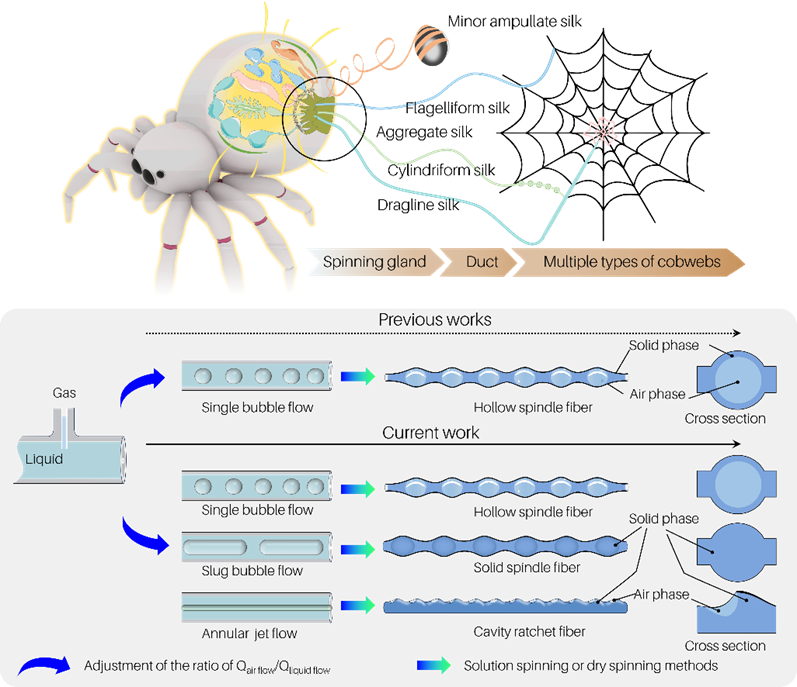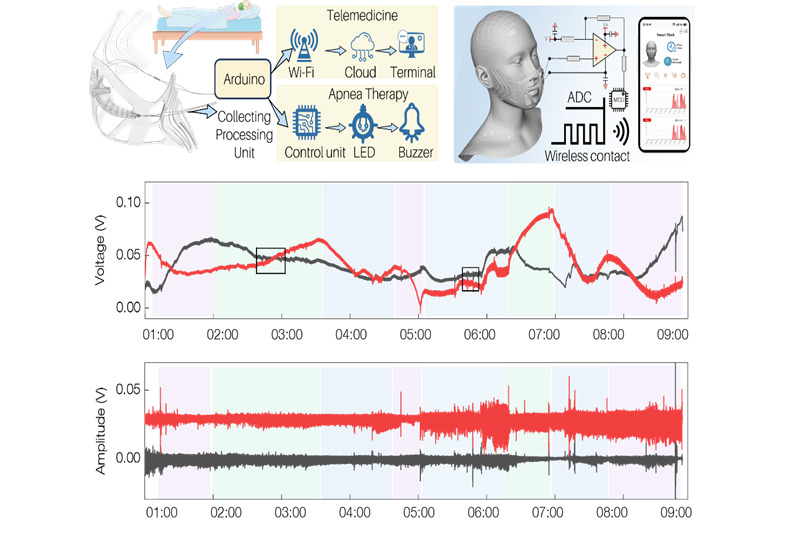Recently, Prof. Xuanyong Liu's team in the college of Biomedical and Engineering has made significant progress in the field of wearable health monitoring. The research team pioneered a method to mimic the dynamic deformation of the gel-liquid interface induced by an air-liquid two-phase flow bubble, and constructed functional fibers with periodic heteromorphic structure. This technological breakthrough realizes the fiber's rapid response to humidity changes and hydrovolt energy harvesting in the human microenvironment, providing a new technological path for future wearable medical devices and health monitoring systems. The relevant results were published in the international journal Nature Communications with a paper titled ‘Gas-liquid two-phase bubble flow spinning for hydrovoltaic flexible electronics’.
In this technique, the researchers designed a gas-liquid two-phase spinning system that mimics the structure of a spider's spinneret. Fibers are cross-linked by calcium ions during contact at the gas-liquid interface for rapid curing, leading to structural stereotyping. Specifically, the single bubble flow condition formed a cavity spindle junction structure, which enhanced the water retention of the fiber; the bubble plug flow generated a solid spindle structure; and the high-speed annular bubble flow resulted in a sawtooth-like periodic structure on the fiber surface. The above multimodal structures are obtained by fine control of the bubble flow pattern without changing the shape of the conventional spinneret, which reflects the innovation of this technology.

(Spider multimodal spinning/comparison of this technology and previous work)
The prepared smart fibers combine excellent flexibility and mechanical fitness, exhibit unique asymmetric wettability on the fiber surface, and possess efficient water transport capability. The optimized cavity spindle junction structure significantly enhances the hydrovoltaic performance by boosting the water retention of the fibers, while the serrated fibers show a sensitive response to small moisture changes caused by respiration by virtue of their directional transport properties. The experimental results show that these smart fibers are able to respond quickly to weak changes in the environment, such as humidity, and continuously and stably output hydrovoltaic power, providing self-powering capability for wearable sensors.

(From gas-liquid two-phase flow to dynamically modulated fiber interfacial configurations)
Focusing on biomedical engineering applications, this research demonstrates the potential of smart fibers in wearable respiratory monitoring systems. The team combined e-fiber sensing elements with a 3D printed mask to enable real-time monitoring of different respiratory states. In addition, the team designed and built an integrated respiratory monitoring and diagnostic system. The system mainly consists of a signal acquisition unit, a signal processing and control unit, a wireless transmission module, and an output feedback unit. The system transmits the monitored respiratory signals to cell phones or computing terminals in real time via a wireless network, thus providing remote diagnosis and intelligent intervention capabilities. In addition, the smart mask is flexible enough to fit the wearer's face, and the fiber sensing unit is fixed in a multi-chamber structure for easy replacement. In the test, the system successfully differentiated and recorded multiple breathing patterns such as normal breathing, post-exercise breathing, and obstructive sleep apnea hypoventilation syndrome (OSAHS).
This work not only breaks the technological bottleneck in the fabrication of traditional fiber structures, but also provides a new paradigm for the construction of structurally programmable smart textiles and biomimetic medical materials. The research also applies the method to a variety of spinning systems, including sodium alginate, carboxymethyl cellulose and polyvinyl alcohol, demonstrating the versatility and scalability of the method, and providing a new theoretical foundation and technical support for the development of flexible hydrovoltaic energy and multi-field coupled sensing platforms.

(Respiratory Monitoring Mask and Telemedicine System)
The corresponding authors of this work are Prof. Xuanyong Liu and Associate Researcher Jiajun Qiu, and the first author is Yuanming Cao, a PhD student at the School of Biological and Medical Engineering of the University. The above work was supported by the Special Funds for Basic Research Operating Costs of the Central Universities and the Major/Key Projects of the National Key Laboratory of Advanced Fiber Materials, and has been applied for relevant patents.
Link to original article:https://www.nature.com/articles/s41467-025-59585-6
